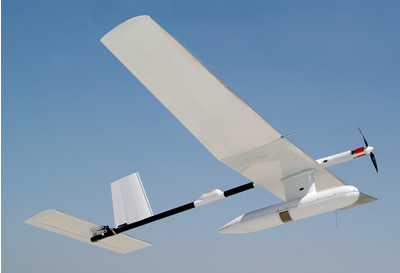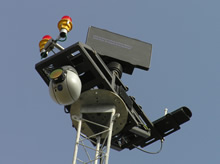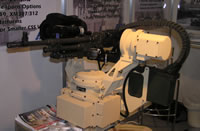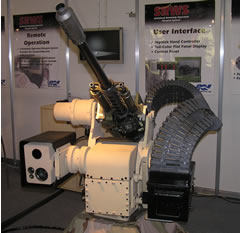GoldenEye-50 unmanned aerial vehicle (UAV), a vertical takeoff and landing aircraft is designed to carry surveillance and chemical agent detection sensors to restricted, hard to reach, or dangerous locations.
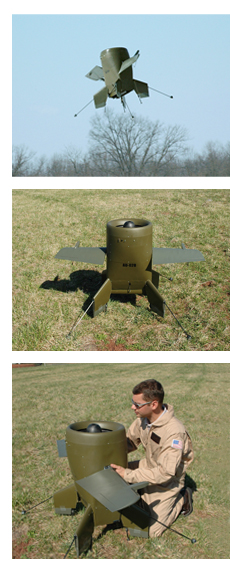 GoldenEye 80 is the third version of vertical takeoff and landing (VTOL) capable aerial vehicle designed by Aurora Flight Sciences under the Defense Advanced Research Projects Agency (DARPA) programs. It is being developed under the Organic Air Vehicle (OAV-II) program, addressing requirements for the U.S. Army’s Future Combat Systems (FCS) program.The 65 inch long (1.65 m’), 150 pounds (68 kg) uses a propulsion system based on heavy fuel (diesel) engine, embedded in a ducted fan assembly, enabling both forward or vertical flight and hovering, with very low acoustic signature. GoldenEye 80 takes off and lands vertically but can transition to horizontal flight using wings. Because GoldenEye 80 is fully autonomous, a pilot is not required to fly the aircraft. It is designed to carry an advanced multi-sensor payload, comprising a high resolution video camera, a high resolution infrared camera for night viewing, a laser rangefinder, a laser tracker, and a laser designator. The payload is under developed by FLIR Systems, under a separate program managed by the US Army’s Night Vision Lab.
GoldenEye 80 is the third version of vertical takeoff and landing (VTOL) capable aerial vehicle designed by Aurora Flight Sciences under the Defense Advanced Research Projects Agency (DARPA) programs. It is being developed under the Organic Air Vehicle (OAV-II) program, addressing requirements for the U.S. Army’s Future Combat Systems (FCS) program.The 65 inch long (1.65 m’), 150 pounds (68 kg) uses a propulsion system based on heavy fuel (diesel) engine, embedded in a ducted fan assembly, enabling both forward or vertical flight and hovering, with very low acoustic signature. GoldenEye 80 takes off and lands vertically but can transition to horizontal flight using wings. Because GoldenEye 80 is fully autonomous, a pilot is not required to fly the aircraft. It is designed to carry an advanced multi-sensor payload, comprising a high resolution video camera, a high resolution infrared camera for night viewing, a laser rangefinder, a laser tracker, and a laser designator. The payload is under developed by FLIR Systems, under a separate program managed by the US Army’s Night Vision Lab.
GoldenEye 80 is the third generation ducted fan aircraft developed by Aurora. The first, GoldenEye 100, was a proof of concept aircraft first flown in 2003 under the “Clandestine UAV” project. This success led a smaller aircraft, the GoldenEye 50, which in 2005 successfully demonstrated the ability to transition to and from horizontal flight using wings that “float” rather than being rigidly attached to the plane’s body. GoldenEye 80 combines the stealth features and the performance features of the earlier programs with a heavy fuel engine and an advanced sensor payload to create a mature and effective system. Aurora’s partners in the GoldenEye development program include General Dynamics Robotics Systems, Northrop Grumman Corporation, and Athena Technologies.
Aurora is currently building the first of four GoldenEye-50 flight test aircraft. GoldenEye-50 made its first flight in July 2004. First autonomous transition to and from horizontal flight was performed in April 2005. Demonstrated were performed to US Army Ranger, Cavalry and Artillery and the forces of a NATO country. During this period Goldeneye 50 performed over 35 flights. GoldenEye family UAVs platforms were selected by DARPA to provide the basic platform for the OAV II Program, expected to be integrated into the US Army FCS program. The UAV is being developed by Team GoldenEye, an industry team led by Aurora Flight Sciences with Northrop Grumman, Signal Systems Corporation and General Dynamics Robotics Systems.
Designed for a wide array of missions including ship-based operations, the fully-VTOL aircraft has the capability to provide maritime law enforcement teams with a bird’s-eye-view during interdiction and boarding operations, and first responders with reach into dangerous areas and over obstacles. Low acoustic signature is an important feature required for the OAV’s clandestine surveillance mission, because it reduces the standoff distance required for the aircraft to perform surveillance without being observed. According to Matt Hutchison, Aurora’s Vice President of Tactical Systems: “Our work on GoldenEye’s muffler system has created a new standard in acoustic signature suppression for ducted fans without sacrificing engine power or payload capacity,” In flight tests the UAV demonstrated acoustic signatures consistently below limits set by DARPA for the OAV-II program.
Goldeneye’s design offers rapid transition from hover to horizontal flight and high-speed dash performance. Among GoldenEye’s many features is unconventional performance that enables it to take-off and land vertically, like a helicopter, then level off into horizontal flight by virtue of rotating wings. Goldeneye 50
GoldenEye’s engine is housed in a ducted-fan configuration that includes a propeller fully-enclosed within a cylindrical body – a design that integrates advanced lightweight structures and innovative flight controls to achieve remarkable performance. This configuration makes it safer for people working in the area of operation, and also makes the GoldenEye-50 quieter than a similarly sized helicopter. Golden-Eye-50 is the GuideStar flight control system developed by Aurora’s sister company, Athena Technologies. GoldenEye-50 stands 70 cm tall, has a wingspan of 1.4 m’, has a gross takeoff weight of 10 kg, and has a payload of 1 kg. The aircraft can cruise up to 1 hour at 100 km/h with a maximum speed of 280 km/h.
The GoldenEye-50 is derived from the larger GoldenEye-100. Originally developed under DARPA’s Clandestine UAV (CUAV) program, GoldenEye-100 carries a 11 kg payload. Flight testing of this aircraft began in September 2003.




